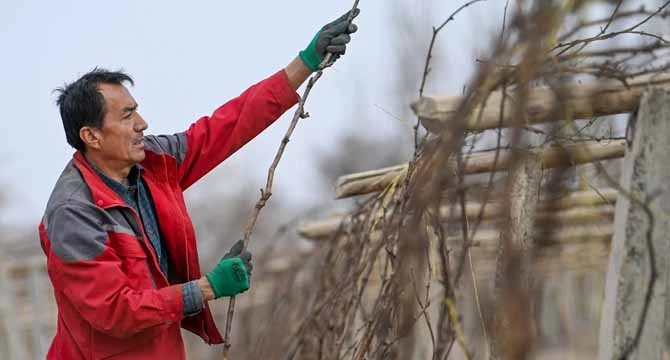URUMQI, March 22 (Xinhua) — As the weather gets warm, farmers in Turpan City of northwest China’s Xinjiang Uygur Autonomous Region dig out grapevines, which they buried underground to resist cold in winter, and put them on trellises.
However, for Usman Abla in Yingsa Village, what he is concerned about the most in the spring plowing season is not farming his ten mu (about 0.67 hectares) grape yard but how to ensure all 175 households of his cooperative could get access to farming machines in time.
“A cooperative is like a family. Helping our members grow grapes well matters a lot,” said the 36-year-old Uygur man who heads the agricultural machinery cooperative — Turpan City No.1 Red Pomegranate.
The cooperative has over ten machines for grapevine digging, burying, protection, and transport.
“In the past, two people could dig up one mu of grapevines a day. With the help of machines, they can dig up ten mu a day,” he said, adding that without the help of machines, grape farming is highly labor-intensive and low-efficient.
However, purchasing machines is too expensive and not economical for a single farmer.
Zeng Jie provided a solution to tackle the dilemma — establishing a cooperative so that farmers can share the cost and machines. He is a member of the work team sent to Xinjiang from central China’s Hunan Province through a pairing-up assistance program. He has served as deputy head of the agriculture and rural affairs bureau of Turpan City since 2020.
Based on the idea, Usman Abla established the Turpan City No.1 Red Pomegranate Cooperative, with 40 percent of the funds coming from Hunan’s pairing-up assistance program, 30 percent from the government’s agricultural machinery purchase subsidies, and 30 percent from members.
Through using the machines of the cooperative, grape farmers can save over 600 yuan (about 87 U.S. dollars) per mu. Last year, the cooperative also helped its members sell more than 1,200 tonnes of grapes.
With its dry and sunny climate, Turpan is one of China’s main grape production bases. Over the past two years, the city has seen a significant improvement in the mechanization of grape production, said Zeng, adding that for farmers to live a better life, it is essential to relieve them from heavy manual labor and increase their income.
“Cooperatives have brought modern agricultural machines and technologies to farmers in Xinjiang, providing them access to the production method and lifestyle outside the region,” said Yu Yinshan, an official of Yingsa Village.
As one of the primary pastoral areas in China, Xinjiang has also seen a boom in husbandry cooperatives, which have been playing an active role in boosting the development of the region’s livestock husbandry and increasing herdsmen’s income.
The Kazakh herdsmen in Aksu Township, Dabancheng District of Urumqi, the regional capital, have a long history of breeding camels.
The township has about 3,600 camels and nine camel breeding and milk sales cooperatives. Herdsmen from 107 households participate in camel breeding and milking and receive dividends from the cooperatives.
“Each camel used to produce 1.5 to 2 kg of milk daily. But the daily milk yield has increased to 3 kg since a new breeding mode involving herdsmen, cooperatives, and enterprises has been introduced,” said Dumanbek Sultan, a Party official of the township.
In March, an industrial park focusing on camel dairy products went into operation in Dabancheng District. The park opened a camel breeding center in the Aksu township, with the aim of guiding local herdsmen and cooperatives to raise camels in a standardized and professional manner.
Statistics released by the regional agriculture and rural affairs department and the regional market regulation administration showed over 3,600 cooperatives operating in Xinjiang in 2010. The figure soared to 47,000 by the end of June 2022. These cooperatives have expanded from traditional planting and breeding to more fields, including agricultural machinery, plant protection, folk crafts, tourism and leisure agriculture, and e-commerce.

